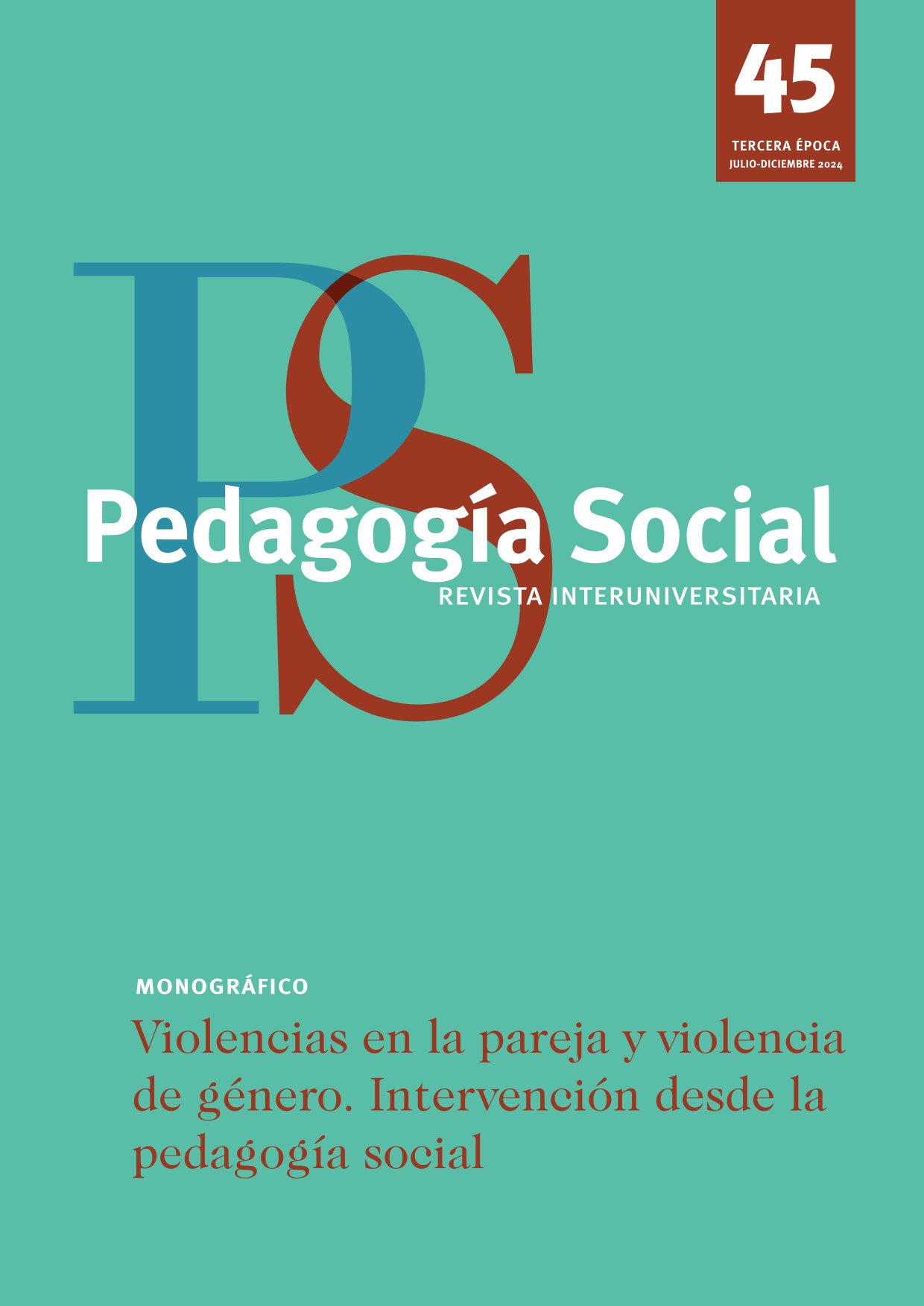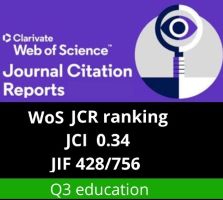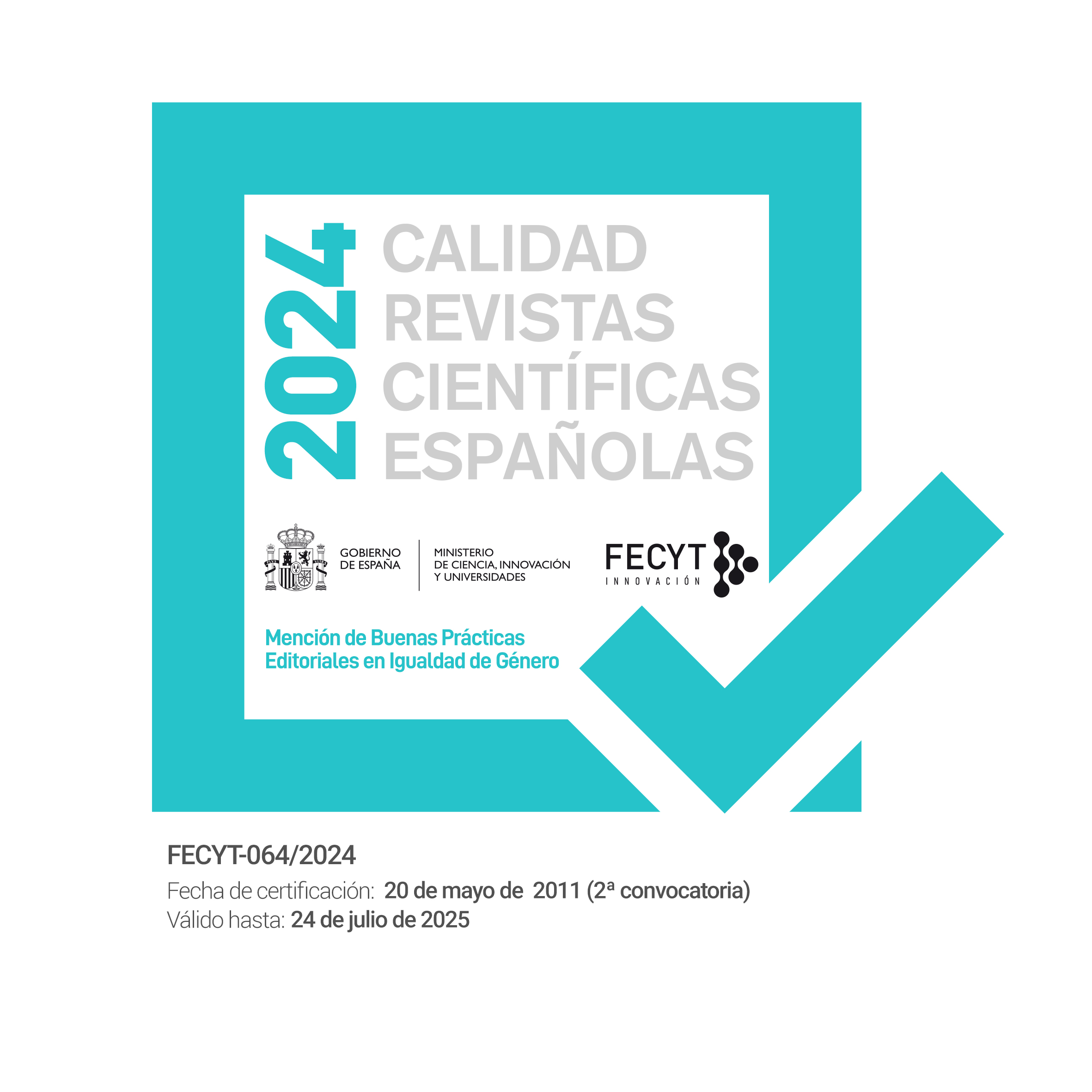¿Qué opinan las personas jóvenes sobre la violencia en la pareja adolescente? Un estudio cuantitativo desde un enfoque transcultural
DOI:
https://doi.org/10.7179/PSRI_2024.45.03Palabras clave:
Violencia en la Pareja Adolescente, percepciones, transculturalidad, prevención, Educación SocialResumen
La Violencia en Pareja Adolescente (VPA) se está convirtiendo en un tópico de interés creciente dentro de la investigación socioeducativa en España. De las diferentes aproximaciones con las que se cuenta, la perspectiva transcultural es la que presenta un menor desarrollo en nuestro contexto, no así en otros como el anglosajón. El objetivo de esta investigación fue conocer las actitudes y percepciones de una muestra de jóvenes de la provincia de Cuenca (España) en relación con la VPA desde una perspectiva transcultural y valorar las implicaciones desde la pedagogía social. La muestra estuvo formada por 394 adolescentes de cuatro institutos de educación secundaria, con una edad media de 15.73 (DT = 1.163), siendo el 53.80 % (n = 212) chicas y el 46.20 % (n = 182) chicos. Mediante un método de encuesta se ha aplicado el módulo I del Sondeo nº4 del Instituto Nacional de Juventud de Chile (2016). Los resultados informan que los celos y el control son actitudes preponderantes en relación con la VPA. Se evidencia la existencia de actitudes sexistas en los varones adolescentes creyentes, en los de menor edad y latinoamericanos. También se observa un nivel de aceptación más elevado en la actitud de coerción sexual en varones adolescentes y un nivel de aceptación de la VPA emocional, verbal y psicológica mayor en ellos también y en adolescentes latinoamericanos. Destaca la creencia errónea de que el control y los celos son manifestaciones de amor, especialmente entre adolescentes más jóvenes. Estos hallazgos arrojan luz sobre la complejidad de la VPA con implicaciones socioeducativas significativas. La comprensión de estas actitudes es esencial para diseñar intervenciones educativas que promuevan relaciones saludables y prevengan la naturalización de relaciones violentas en las parejas adolescentes. Se aportan una serie de propuestas relacionadas con la intervención socioeducativa ante la VPA a la luz de los resultados de este estudio.
Descargas
Citas
Archer, J. (2006). Cross-Cultural differences in physical aggression between partners: A social-role analysis. Personality and Social Psychology Review, 10(2), 133-153. https://doi.org/10.1207/s15327957pspr1002_3
Baiden, P., Mengo, C., y Small, E. (2019). History of physical teen dating violence and its association with suicidal behaviors among adolescent high school students: results from the 2015 youth risk behavior survey. Journal of Interpersonal Violence, 36(17-18), NP9526-NP9547. https://doi.org/10.1177/0886260519860087
Baker, C. K. (2016). Dating violence and substance use: Exploring the context of adolescent relationships. Journal of Interpersonal Violence, 31(5), 900-919. https://doi.org/10.1177/0886260514556768.
Ballesteros, J. C., Rubio, A., Sanmartín, A., y Tudela, P. (2019). Barómetro juventud y género 2019. Identidades y representaciones en una realidad compleja. Centro Reina Sofía sobre Adolescencia y Juventud, Fad. http://www.adolescenciayjuventud.org/que-hacemos/monografias-y-estudios/ampliar.php/Id_contenido/127043/.
Borrajo, E., Gámez-Guadix, M., y Calvete, E. (2015). Justification beliefs of violence, myths about love and cyber dating abuse. PubMed, 27(4), 327-333. https://doi.org/10.7334/psicothema2015.59
Cabello, E., Pérez, N., Ros, A., y Filella, G. (2019). Los programas de educación emocional happy 8-12 and happy 12-16. Evaluación de su impacto en las emociones y el bienestar. Revista Española de Orientación y Psicopedagogía, 30(2), 53. https://doi.org/10.5944/reop.vol.30.num.2.2019.25338
Caetano, R. et al., (2007). Acculturation stress, drinking, and intimate partner violence among Hispanic couples in the US. Journal of Interpersonal Violence, 22(11), 1431-1447. https://doi.org/10.1177/0886260507305568
Cala, V, y Álvarez, D. M. G. (2021) ¿Influyen los valores hacia la pareja sobre la violencia sufrida en el noviazgo adolescente? Diversitas, 17(1). https://doi.org/10.15332/22563067.6533
Cala, V., y del Carmen, M. (2022). Ciberviolencia en la pareja adolescente: análisis transcultural y de género en centros de secundaria. Bordón, 74(2), 11-30. https://doi.org/10.13042/bordon.2022.91342
Cala, V. y Soriano-Ayala, E. S. (2021). Cultural dimensions of immigrant teen dating violence: A qualitative metasynthesis. Aggression and Violent Behavior, 58, 101555. https://doi.org/10.1016/j.avb.2021.101555
Cala, V. y Soriano-Ayala, E. S. (2023). Conflictos culturales en las relaciones de pareja en adolescentes de origen marroquí en el sureste español. International Journal of Sociology of Education, 12(1), 85-110. https://doi.org/10.17583/rise.10746
Calvete, E., Gámez-Guadix, M., y Borrajo, E. (2019). Cyberbullying in romantic relationships: Cross-cultural issues. En G. W. Giumetti y R. M. Kowalski (Eds.), Cyberbullying in schools, workplaces, and romantic relationships: The many lenses and perspectives of electronic mistreatment (pp. 150–183). Routledge/Taylor y Francis Group. https://doi.org/10.4324/9781315110554-10
Cantera, I., Estébanez, I., y Vázquez, N. (2009). Violencia contra las mujeres jóvenes: la violencia psicológica en las relaciones de noviazgo. Gobierno Vasco. https://ianireestebanez.com/recursos/
Dalouh R., González Jiménez A. J., y Rodríguez Martínez D. (2023). Violencia en el noviazgo adolescente desde la perspectiva de los profesionales socioeducativos. Un estudio cualitativo. Revista Complutense de Educación, 34(3), 507-517. https://doi.org/10.5209/rced.79495
Datta, P., Cornell, D. G., y Konold, T. R. (2020). Association of teen dating aggression with risk behavior and academic adjustment. Journal of Interpersonal Violence, 37(7-8), NP3930-NP3953. https://doi.org/10.1177/0886260520951305
De la Villa, M., García, A., Cuetos, G., y Sirvent, C. (2017). Violencia en el noviazgo, dependencia emocional y autoestima en adolescentes y jóvenes españoles. Revista Iberoamericana de Psicología y Salud, 8(2), 96-107. https://www.rips.cop.es/pdf/art92017e9.pdf
Del Pozo Serrano, F. J. (Comp.) (2020). Fundamentos, investigación, estrategias y educación social en el ciclo vital. Universidad del Norte. https://editorial.uninorte.edu.co/gpd-intervencion-educativa-en-contextos-sociales.html
Delegación de la Violencia de Género (2021). La situación de la violencia contra las mujeres en la adolescencia en España. https://bit.ly/3wMPR3h
Díaz– Aguado, M.J., Martínez, R. y Martín, J. (2020). Menores y violencia de género. Delegación del Gobierno contra la Violencia de Género. Ministerio de Igualdad. https://violenciagenero.igualdad.gob.es/violenciaEnCifras/estudios/investigaciones/2020/pdfs/Estudio_menores_final.pdf
Díaz-Aguado, M. J., y Carvajal, M. I. (2011). Igualdad y prevención de la violencia de género en la adolescencia. Ministerio de Sanidad, Política Social e Igualdad. https://www.inmujeres.gob.es/publicacioneselectronicas/documentacion/Documentos/DE0138.pdf
Diputación de Granada (2023). Ligando de buen rollo [Software]. https://www.dipgra.es/servicios/areas/igualdad/ha-pasado/ligando-de-buen-rollo/
DuPont-Reyes, M. J., et al. (2014). Relationship violence, fear, and exposure to youth violence among adolescents in New York City. Journal of Interpersonal Violence, 29(12), 2325-2350. https://doi.org/10.1177/0886260513518433
Fernández, L., Rodríguez, L., Molleda, C., y Rodríguez, F. (2015). Relaciones de noviazgo en jóvenes. Maltrato y religión. Infancia, Juventud y Ley, 6, 44-50. https://paip-publicaciones.blogspot.com/p/infancia-juventud-y-ley.html
Fernández, M., y García, H. (2023). Violencia entre parejas adolescentes: programas de prevención primaria. Una revisión sistemática. Trabajo Fin de Máster. UOC. https://openaccess.uoc.edu/bitstream/10609/148256/1/mireiafersaTFM0123memoria.pdf
Giuliani, C. (2017). Teen dating violence and post-migration factors: The psychosocial literature. Maltrattamento e Abuso all’Infanzia, 19(3), 31-48. https://doi.org/10.3280/MAL2017-003003
INE. (2020). Estadística de violencia doméstica y violencia de género año 2019. https://www.ine.es/prensa/evdvg_2019.pdf
Instituto Nacional de la Juventud (INJUV, 2016). Sondeo N.º 4 Violencia en el Pololeo. Chile. https://www.injuv.gob.cl/sites/default/files/sondeo_violencia_en_el_pololeo.pdf
Jiménez, T., Lombas, A. S., Jiménez, T., Lucas-Alba, A., y Blasco, V. J. V. (2022). Profiles and risk factors for teen dating violence in Spain. Journal of Interpersonal Violence, 38(3-4), 4267-4292. https://doi.org/10.1177/08862605221114305
Jimeno, M. V., y Cantero. M. J. (2020). Percepción de la violencia psicológica hacia la mujer en la relación de pareja y sexismo en adolescentes en acogimiento residencial: comparación con un grupo de adolescentes no institucionalizados.
Revista Española de Investigación Criminológica, 18(1), 1-21. https://doi.org/10.46381/reic.v18i0.299
Junta de Andalucía (2023). DectAmor [Software]. https://www.juntadeandalucia.es/institutodelamujer/index.php/areas-tematicas-coeducacion/app-detectamor
Kerig, P. K., Volz, A. R., Moeddel, M. A., y Cuellar, R. E. (2010). Implementing dating violence prevention programs with flexibility, fidelity, and sensitivity to diversity: Lessons learned from expect respect. Journal of Aggression, Maltreatment y Trauma, 19(6), 661-680. https://doi.org/10.1080/10926771.2010.502079
Kumah, E. et al. (2022). Evidence-informed vs evidence-based practice educational interventions for improving knowledge, attitudes, understanding and behaviour towards the application of evidence into practice: A comprehensive systematic review of undergraduate students. Campbell Systematic Reviews, 18(2). https://doi.org/10.1002/cl2.1233
Lameiras, M. y Rodríguez, Y. (2002). Evaluación del sexismo moderno en adolescentes. Revista de Psicología Social, 17(2), 119-127. https://doi.org/10.1174/021347402320007555
López-Barranco, P. J., et al. (2022). Systematic review and meta-analysis of the violence in dating relationships in adolescents and young adults. Revista Iberoamericana de Psicología y Salud, 13(2), 73-84. http://dx.doi.org/10.23923/j.rips.2022.02.055
López-Garrido, F.M. y Sánchez-Santamaría, J. (2024). La violencia en la pareja adolescente: claves psicológicas y educativas para su prevención. II Congreso Internacional de Formación en la Práctica de la Psicología. CIFPPs 2024. México.
Ludin, S., et al. (2017). A cross-national comparison of risk factors for teen dating violence in Mexico and the United States. Journal of Youth and Adolescence, 47(3), 547-559. https://doi.org/10.1007/s10964-017-0701-9
Makepeace, J. M. (1981). Courtship violence among college students. Family Relations, 97-102. https://www.jstor.org/stable/584242
Malhotra, K., González-Guarda, R. M., y Mitchell, E. M. (2015). A review of teen dating violence prevention research: What about Hispanic youth? Trauma, Violence, y Abuse, 16(4), 444-465. https://doi.org/10.1177/1524838014537903
Mark, G. Y., y Nishigaya, L. (2009). Asian American and Pacific Islander youth violence and prevention. Aggression y Violent Behavior, 14(6). https://doi.org/10.1016/j.amepre.2007.12.011
McDonell, J., Ott, J., y Mitchell, M. A. (2010). Predicting dating violence victimization and perpetration among middle and high school students in a rural southern community. Children and Youth Services Review, 32(10), 1458-1463. https://doi.org/10.1016/j.childyouth.2010.07.001
McMillan, J. H. y Schumacher, S. (2018). Investigación educativa (5ª edición). Pearson-Addison Wesley.
Melendro, M. E. (coord.) (2014). Estrategias eficaces de intervención socioeducativa con adolescentes en riesgo de exclusión. UNED.
Ministerio de Igualdad. (2019). Macroencuesta de violencia contra la mujer. https://violenciagenero.igualdad.gob.es/violenciaEnCifras/macroencuesta2015/Macroencuesta2019/home.htm
Molina-Martínez, R., Griffith, V. M., y González, J. H. (2021). Percepción acerca de la violencia en el noviazgo en mujeres y hombres adolescentes de 15 años de un establecimiento educacional de la ciudad de Antofagasta, Chile. Opción: Revista de Ciencias Humanas y Sociales, 37(95), 125-146. https://doi.org/10.5281/zenodo.7467818
Monks, C. P., Palermiti, A., Ortega, R., y Costabile, A. (2011). A cross-national comparison of aggressors, victims and defenders in Preschools in England, Spain and Italy. The Spanish Journal of Psychology, 14(1), 133-144. https://doi.org/10.5209/rev_sjop.2011.v14.n1.11
Montero-Fernández, D., García, A. D., Hernando, A., y Del Río, F. J. (2022). Validación del cuestionario de violencia digital (Digital Violence Questionnaire, DVQ) en la pareja sentimental. RELIEVE – Revista Electrónica de Investigación y Evaluación Educativa, 28(2). https://doi.org/10.30827/relieve.v28i2.26142
Muñoz, M. A. G., et al. (2022). Short version of the Multidimensional Scale of Dating Violence (MSDV 2.0) in Spanish-language: Instrument development and psychometric evaluation. Journal of Advanced Nursing, 79(4), 1610-1631. https://doi.org/10.1111/jan.15300
Ortega, R., Rivera, F. J. O., y Sánchez, V. B. (2008). Violencia sexual entre compañeros y violencia en parejas adolescentes. International Journal of Psychology and Psychological Therapy, 8(1), 63-72. https://www.ijpsy.com/volumen8/num1/184/violencia-sexual-entre-compaeros-y-violencia-ES.pdf
Padrós, M., Aubert, A., y Melgar, P. (2010). Modelos de atracción de los y las adolescentes. Contribuciones desde la socialización preventiva de la violencia de género. Pedagogía Social. Revista Interuniversitaria, 17, 73-82. https://doi.org/10.7179/psri_2010.17.06
Pereda, N., Codina, M., y Díaz-Faes, D. Teen dating violence #TheSocialObservatory of #laCaixaFoundation (1 de marzo 2024). El Observatorio Social – Fundación La Caixa. https://elobservatoriosocial.fundacionlacaixa.org/en/-/teen-dating-violence
Piolanti, A. y Foran, H. M. (2022). Psychological violence in dating relationships among adolescents: A systematic review and meta-analysis of prevention programs. Preventive Medicine, 159, 107053. https://doi.org/10.1016/j.ypmed.2022.107053
Pradubmook-Sherer, P. (2010). Youth attitudes toward dating violence in Thailand. International Journal of Offender Therapy and Comparative Criminology, 55(2), 182-206. https://doi.org/10.1177/0306624x09360659
Ragavan, M., Syed-Swift, Y., Elwy, A. R., Fikre, T., y Bair-Merritt, M. (2021). The influence of culture on healthy relationship formation and teen dating violence: A qualitative analysis of South Asian female youth residing in the United States. Journal of Interpersonal Violence, 36(7-8). https://doi.org/10.1177/0886260518787815
Rangel, Y. R., Ángulo, L. L., Pompa, M. S., y Ramos, D. G. (2021). Percepción de violencia en el noviazgo: un acercamiento a su análisis en estudiantes de medicina. Medisur, 19(1), 63-70. http://scielo.sld.cu/pdf/ms/v19n1/1727-897Xms-19-01-63.pdf
Raykov, T., y Marcoulides, G. A. (2017). Thanks coefficient Alpha, we still need you! Educational and Psychological Measurement, 79(1), 200-210. https://doi.org/10.1177/0013164417725127
Rebollo-Catalán, A., De los Santos-Martínez, P., y Jiménez-Cortés, R. (2022). Recursos que ayudan a las adolescentes a recuperarse de una experiencia de violencia de género en el noviazgo. Revista de Investigación Educativa,40(1), 203-218. https://doi.org/10.6018/rie.463081
Rodríguez-Sola, D. y Soriano-Ayala, E. (2022). Violencia en las parejas adolescentes: Implicaciones del sexismo y la religión. Interdisciplinaria: Revista de Psicología y Ciencias Afines, 39(1), 41-56. https://doi.org/10.16888/interd.2022.39.1.3
Samaniego E., y Freixas, F. (2010). Estudio sobre la identificación y vivencia de violencia en parejas adolescentes. Apuntes de Psicología, 28(3), 349-366. https://www.apuntesdepsicologia.es/index.php/revista/article/view/224
Sánchez-Santamaría, J. y López-Garrido, F. M. (2024a). Informe de investigación sobre percepciones y actitudes de una muestra de adolescentes hacia la Violencia en Pareja Adolescente desde una perspectiva transcultural. Zenodo. https://doi.org/10.5281/zenodo.10827147
Sánchez-Santamaría, J. y López-Garrido, F.M. (2024b). Celos y redes sociales, una combinación peligrosa en las relaciones adolescentes. The Conversation. https://theconversation.com/celos-y-redes-sociales-una-combinacion-peligrosa-en-las-relaciones-adolescentes-226051
Sánchez-Santamaría, J., Boroel, B., y de la Cruz, G. (2024). Presentación del monográfico sobre competencia investigadora en la Educación: desafíos y oportunidades. Alteridad. Revista de Educación, 19(2), 1-4. https://alteridad.ups.edu.ec/index.php/alteridad/announcement/view/116
Sánchez-Santamaría, J., Olmedo, E., Ballester-Vila, M.G., y Boroel, B., (en prensa, 2024). Práctica educativa informada por la evidencia: la competencia investigadora con apoyo de la inteligencia artificial desde el up-skilling. UTE Teaching y Technology (Universitas Tarraconensis). Monográfico FIET. https://revistes.urv.cat/index.php/ute/about
Save The Children España. (2021). No es amor: un análisis sobre la violencia de género entre adolescentes. https://www.savethechildren.es/actualidad/informe-no-es-amor
Sedano, S., Lorente, J., Ballester, Ll., y Aznar, B. (2024). Acceso, consumo y consecuencias del consumo de pornografía entre adolescentes: nuevos retos para la educación afectivo-sexual. Pedagogía Social. Revista Interuniversitaria, 44, 161-175. https://doi.org/10.7179/psri_2024.44.09
Shaffer, C., Corona, R., Sullivan, T. N., Fuentes, V. E., y McDonald, S. E. (2017). Barriers and supports to dating violence communication between Latin adolescents and their mothers: A qualitative analysis. Journal of Family Violence, 33(2), 133-145. https://doi.org/10.1007/s10896-017-9936-1
Soriano, E., Rey, C. A., y Lozano, J. (ed.), (2022). Violencia en las relaciones de noviazgo adolescente. Estrategias para el cambio. Narcea.
Taylor, S., Calkins, C. R., Xia, Y., y Dalla, R. L. (2017). Adolescent perceptions of dating violence: A qualitative study. Journal of Interpersonal Violence, 36(1-2), 448-468. https://doi.org/10.1177/0886260517726969
Tomaszewska, P., y Schuster, I. (2021). Prevalence of teen dating violence in Europe: a systematic review of studies since 2010. New Directions for Child and Adolescent Development, 178, 11-37. https://doi.org/10.1002/cad.20437
Tourón, J. (ed.) (2023). Análisis de datos y medida en educación. UNIR. https://reunir.unir.net/handle/123456789/14595
Velasco, L., Thomas-Currás, H., Pastor-Ruiz, Y., y Arcos-Rodríguez, A. (2022). PRO-Mueve Relaciones Sanas – A gender-based violence prevention program for adolescents: Assessment of its efficacy in the first year of intervention. Frontiers in Psychology, 12, 744591. https://doi.org/10.3389/fpsyg.2021.744591
Víllora, B., Navarro, R., y Jiménez, S. Y. (2019). Abuso online en el noviazgo y su relación con el abuso del móvil, la aceptación de la violencia y los mitos sobre el amor. Suma Psicológica, 26(1), 46-54. https://doi.org/10.14349/sumapsi.2019.v26.n1.6
Vizoso-Gómez, C., y Fernández-Gutiérrez, A. (2022). Teen dating violence socio-educational preventive program. International Journal of New Education, (10), 87–102. https://doi.org/10.24310/IJNE.10.2022.15556
World Health Organization. (2021). Violence against women prevalence estimates, 2018: global fact sheet. https://www.who.int/publications/i/item/978924002225
Descargas
Publicado
Cómo citar
Número
Sección
Licencia

Esta obra está bajo una licencia internacional Creative Commons Atribución-NoComercial-CompartirIgual 4.0.
Derechos de reproducción y archivo
La versión publicada de los artículos podrá ser autoarchivada por sus autores en repositorios institucionales y temáticos de acceso abierto. No obstante la reutilización total o parcial de los mismos en nuevos trabajos o publicaciones deberá ser autorizada por Pedagogía Social. Revista Interuniversitaria.
Los trabajos publicados deberán ser citados incluyendo el título de la Revista, Pedagogía Social. Revista Interuniversitaria, nº, páginas y año de publicación.
Responsabilidades éticas
Pedagogía Social. Revista Interuniversitaria no acepta material publicado anteriormente en otros documentos. Los/as autores/as son responsables de obtener los permisos oportunos para reproducir parcialmente material de otras publicaciones y citar correctamente su procedencia. Estos permisos deben solicitarse tanto al autor/a como a la editorial que ha publicado dicho material.
Es obligación de Pedagogía Social. Revista Interuniversitaria detectar y denunciar prácticas fraudulentas.
En la lista de autores/as firmantes deben figurar únicamente aquellas personas que han contribuido intelectualmente al desarrollo del trabajo.
La revista espera que los/as autores/as declaren cualquier asociación comercial que pueda suponer un conflicto de intereses en conexión con el artículo remitido.
Los autores deben mencionar en el manuscrito, preferentemente en el apartado del método, que los procedimientos utilizados en los muestreos y controles han sido realizados tras la obtención de consentimiento informado.
La revista no utilizará ninguno de los trabajos recibidos con otro fin que no sea el de los objetivos descritos en estas normas.
Aviso de derechos de autor/a
© Pedagogía Social. Revista Interuniversitaria. Los originales publicados en las ediciones impresa y electrónica de esta Revista son propiedad del Pedagogía Social. Revista Interuniversitaria, siendo necesario citar la procedencia en cualquier reproducción parcial o total.
Salvo indicación contraria, todos los contenidos de la edición electrónica se distribuyen bajo una licencia de uso y distribución “Creative Commons Reconocimiento-No Comercial 3.0 España” (CC-by-nc). Puede consultar desde aquí la versión informativa y el texto legal de la licencia. Esta circunstancia ha de hacerse constar expresamente de esta forma cuando sea necesario.






